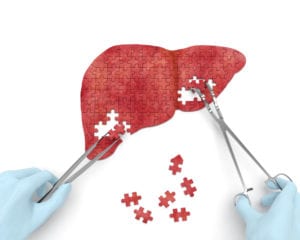Written by Joyce Smith, BS. Researchers find an association between increases in the use of gastric acid-suppressive medications (proton pump inhibitors) and the increasing incidence of chronic liver disease.
 Liver cirrhosis as end-stage liver disease is now the 12th leading cause of death worldwide 1 partly due to the increasing prevalence of obesity associated with non-alcoholic fatty liver disease (NAFLD) and steatohepatitis (NASH) 2. NASH is classically seen in alcoholic liver disease but is also frequently associated with obesity and diabetes. Approximately 50% of all cirrhosis-associated deaths are related to alcohol 3.
Liver cirrhosis as end-stage liver disease is now the 12th leading cause of death worldwide 1 partly due to the increasing prevalence of obesity associated with non-alcoholic fatty liver disease (NAFLD) and steatohepatitis (NASH) 2. NASH is classically seen in alcoholic liver disease but is also frequently associated with obesity and diabetes. Approximately 50% of all cirrhosis-associated deaths are related to alcohol 3.
Very popular and very frequently used by patients with NAFLD is the very commonly prescribed proton pump inhibitor (PPI) called omeprazole (Prilosec). Gastric acid kills ingested microbes, and suppression of gastric acid secretion by PPIs can change the composition of the intestinal microbiota 4. To determine the effect of gastric acid suppression on the progression of chronic liver disease, researchers at the UC San Diego School of Medicine used mouse modals that mimic alcoholic liver disease (ALD), NAFLD and NASH in humans. Gastric acid production was blocked in each mouse model either by genetic engineering or the use of a PPI (omeprazole/Prilosec). Researchers sequenced microbe-specific genes collected from the stools of these mice to determine the gut microbiome makeup of each mouse type, with or without blocked gastric acid production. They found that those with gastric acid suppression developed alterations in their gut microbiomes (P<0.05), particularly, an overabundance of Enterococcus species which promotes liver inflammation and injury, and encourages the progression of all three types of liver disease in the mice: ADL, NAFLD, and NASH. Specifically, the overabundant intestinal Enterococci, translocate to the liver via the portal vein where they bind to the pathogen recognition receptor TLR2 on hepatic Kupffer cells, and promote secretion of the cytokine IL1B. This cytokine contributes to ethanol-induced liver inflammation and hepatocyte (liver cell) damage.
To validate these findings, mice were colonized with the common gut bacteria Enterococcus faecalis to mimic the intestinal overgrowth observed following gastric acid suppression. Enterococcus alone was sufficient to induce mild steatosis and increase alcohol-induced liver disease in mice (P<0.05). Additional analysis of Danish population-based healthcare databases involving 2.2 million inhabitants, validated an association between PPI use and the development of alcoholic liver disease (ALD) among chronic alcohol abusers (P<0.05). Specifically, in this cohort of 4830 Danish alcohol abusers, researchers found that 1,024 (21%) were active PPI users, 745 (15%) were previous users, and 3,061 (63%) had never used PPIs. Furthermore, PPI use among these patients significantly increased their stool concentration of Enterococcus (P<0.05). Finally, following these 3 groups of chronic alcohol abusers for 10 years, researchers succeeded in establishing a 10-year risk of diagnosis of ALD. They found a 20.7% risk of ALD diagnosis for active PPI users, a 16.1% risk of ALD diagnosis for previous users, and a 12.4% risk of ALD diagnosis for those who have never used PPIs (p,<.05).
While this study demonstrates that in alcohol-dependent patients, gastric acid suppression promotes the onset and progression of liver disease, an additional randomized study is necessary to validate current findings. Although obesity and alcohol use predispose to acid reflux requiring antacid medication, many patients with chronic liver disease take gastric acid suppressive medications without appropriate indication 5. Based on the findings of this study, researchers suggest clinicians consider “withholding medications that suppress gastric acid unless there is a strong medical indication.”
Source: Llorente, Cristina, Peter Jepsen, Tatsuo Inamine, Lirui Wang, Sena Bluemel, Hui J. Wang, Rohit Loomba et al. “Gastric acid suppression promotes alcoholic liver disease by inducing overgrowth of intestinal Enterococcus.” Nature communications 8, no. 1 (2017): 837.
© The Author(s) 2017 Open Access licensed under a Creative Commons Attribution 4.0 International License http://creativecommons.org/licenses/by/4.0/.
Click here to read the full text study.
Posted August 7, 2018.
Joyce Smith, BS, is a degreed laboratory technologist. She received her bachelor of arts with a major in Chemistry and a minor in Biology from the University of Saskatchewan and her internship through the University of Saskatchewan College of Medicine and the Royal University Hospital in Saskatoon, Saskatchewan. She currently resides in Bloomingdale, IL.
References:
- Lozano R, Naghavi M, Foreman K, et al. Global and regional mortality from 235 causes of death for 20 age groups in 1990 and 2010: a systematic analysis for the Global Burden of Disease Study 2010. The lancet. 2012;380(9859):2095-2128.
- Wong RJ, Cheung R, Ahmed A. Nonalcoholic steatohepatitis is the most rapidly growing indication for liver transplantation in patients with hepatocellular carcinoma in the US. Hepatology. 2014;59(6):2188-2195.
- Rehm J, Samokhvalov AV, Shield KD. Global burden of alcoholic liver diseases. Journal of hepatology. 2013;59(1):160-168.
- Bajaj JS, Cox IJ, Betrapally NS, et al. Systems biology analysis of omeprazole therapy in cirrhosis demonstrates significant shifts in gut microbiota composition and function. American Journal of Physiology-Gastrointestinal and Liver Physiology. 2014;307(10):G951-G957.
- Rotman SR, Bishop TF. Proton pump inhibitor use in the US ambulatory setting, 2002–2009. PloS one. 2013;8(2):e56060.
